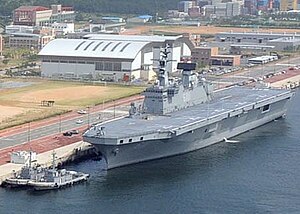Dokdo-class amphibious assault ship
 ROKS Dokdo (LPH 6111) moored at Busan in August 2009.
| |
| Class overview | |
|---|---|
| Builders | Hanjin Heavy Industries & Constructions Co |
| Planned | 3 |
| Completed | 1 |
| General characteristics | |
| Tonnage | 14,300 tons (empty) / 18,800 tons (full) |
| Length | 199 m (653 ft) |
| Beam | 31 m (102 ft) |
| Draught | 7 m (23 ft) |
| Propulsion | 4 S.E.M.T. Pielstick 16 PC2.5 STC Diesel engine |
| Speed | list error: <br /> list (help) 23 knots (43 km/h) maximum 18 knots (33 km/h) cruising |
| Boats & landing craft carried | 2 LSF-II or LCAC |
| Capacity | Up to 200 vehicles |
| Troops | 720 marines, 6 tanks, 7 amphibious assault vehicles |
| Crew | 700 |
| Sensors and processing systems | SMART-L air search radar,MW08 surface search radar,AN/SPS-95K navigation radar, TACAN,VAMPIR-MB optronic sight |
| Electronic warfare & decoys | ESM/ECM:SLQ-200(v)5K SONATA, Chaff launcher |
| Armament | Two Goalkeeper CIWS, One RIM-116 Rolling Airframe Missile |
| Aircraft carried | Up to 15 helicopters (15 UH-60 Black Hawk or 10 SH-60F Ocean Hawk helicopters) 2 LCACs (Landing Craft Air Cushioned) |
| Aviation facilities | Flight deck and hanger |
ROKS Dokdo (LPH 6111) is the lead ship of the "LPX" class of amphibious landing ships of the Republic of Korea Navy, launched on 12 July 2005 at the shipyard of Hanjin Heavy Industries & Constructions Co. in Busan. Named after the Dokdo islets, Dokdo was commissioned into the ROK Navy on 3 July 2007.
Designed by Hanjin Heavy Industries, the requirements for the amphibious landing ships were to enhance Korea's current amphibious operation capability, both in terms of assault and military operations other than war (MOOTW) type operations.
Specifications
The LPX is a versatile amphibious warfare ship, and includes a well deck to accommodate Amphibious Assault Vehicles (AAV's) and two Landing Craft Air Cushion (LCAC), the first of which (LSF 631) was acquired in April 2007. The ship is 199 metres long, 31 metres wide, with a 14,000 ton (empty), or 18,000 ton (full) displacement.
Presently the Dokdo is the largest vessel in the South Korean Navy. Previously, this spot was held by the 9,000-ton at-sea Underway Replenishment (UNREP) support vessel Cheonji.
As a high-speed amphibious ship, LPX was based on the concept of "over-the-horizon assault." As the name indicates, the "over-the-horizon assault" comprises a military operation in which an amphibious landing operation is conducted with high-speed air-cushioned vehicles and helicopters from beyond the horizon, where they can't be easily detected or attacked by the enemy. The conventional LST (landing ship tank) has to approach the coastline for landing, at the risk of being fired upon by the enemy.
The LPX can carry 720 marines (+300 crew members), 10 tanks, 10 trucks, 7 AAVs, three field artillery pieces, 10 helicopters, and two LCAC hovercrafts capable of landing on enemy shores doing 40 knots (74 km/h)—a mix that enables it to launch troop landings from both sea and air.
Self-defense armament includes the RIM-116 Rolling Airframe Missile system. South Korea is only the third country (after Germany and the United States) to put the system into service. The Goalkeeper Close-in weapon system (CIWS) was purchased in January 2003 from Thales, at per-set price of 13,000,000,000 won (roughly $15,000,000).
The flight surface is also sprayed with urethane, which can support VTOL jets, like Harriers.
Dokdo is similar (length and beam) and (total displacement) to the Spanish Navy's current aircraft carrier SPS Príncipe de Asturias and the Thai Navy's HTMS Chakri Naruebet.
Future plans

Some proposed uses for the ship include UN peacekeeping operations and disaster relief. For this reason, the LP-X is expected to usher in a new era of expanded Korean naval activity, since it can be used for relief, transport, and other peacetime activities.
The ROK Navy has plans to develop another similar ship by 2010. This unit will be named after Marado, which is located 11 kilometres offshore from Moseulpo harbor of Jeju. Marado Island is commonly thought of as being both the ending and beginning point of Korea. Today a monument stands there recognizing it as the southernmost point of the country.
The third unit is to be named after Baengnyeong Island, which is located in the Yellow Sea near the disputed Northern Limit Line (NLL) with North Korea. Baekryeong Island is the territory administered by South Korea that is closest to the NLL. It was an important military base and the site of fierce combat during the Korean War.
South Korea is considering the purchase of F-35B fighters to operate from its Dokdo class ships.[1]
First Steps to a Blue Water Navy
In a speech delivered in March 2001, Kim Dae Jung stated that his administration was aiming to build a navy that "will defend the national interests in the five oceans and perform a role in defending world peace." By the year 2020, the ROK Navy plans to deploy two or three rapid response fleets, each comprising of 1 LPX, 2 KDX-III, 4 KDX-II, 1 KDX-I and possibly a number of FFX frigates and two or three SSX submarines.
- See also: Military of South Korea

ROK Navy's Rapid Response Fleet:
- Dokdo class LPH (Flagship)
- King Sejong the Great class destroyer (KDX-III) Aegis Combat System
- KDX-II
- KDX-I
- Type 214 submarine
References
External links
- Articles needing cleanup from March 2010
- Cleanup tagged articles without a reason field from March 2010
- Wikipedia pages needing cleanup from March 2010
- Helicopter carrier classes
- Amphibious warfare vessel classes
- Dokdo class landing platform experimental ships
- Active amphibious warfare vessels of South Korea
